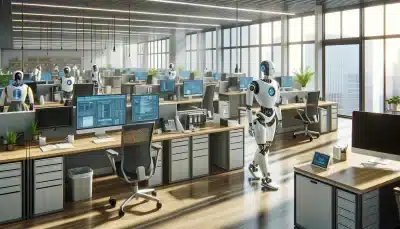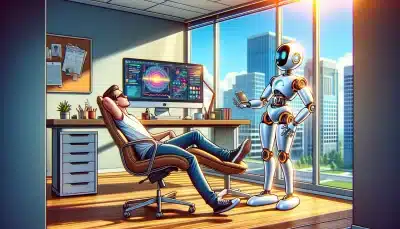In today’s rapidly evolving technological landscape, the advent of artificial intelligence (AI) has sparked both excitement and concern regarding its impact on the job market. The concept of the “AI workforce” is becoming increasingly relevant as businesses across various sectors integrate AI technologies to enhance efficiency, reduce costs, and drive innovation.
This blog post aims to explore the implications of AI on the job market, specifically focusing on the roles that are most likely to be replaced by AI in the coming years. By understanding these changes, individuals and organizations can better prepare for the future, ensuring that they remain competitive and adaptable in an AI-driven world.
IMAGE: OPTICOUS
Understanding the AI Workforce
The integration of the AI workforce signifies a monumental shift in the global economy, with AI expected to contribute up to $15.7 trillion to the world economy by 2030, as per PwC. This includes $6.6 trillion from increased productivity and $9.1 trillion from consumption side effects.
Interestingly, AI is set to enhance the quality of decision-making through data analysis, outperforming human speed and accuracy in specific tasks, such as medical diagnosis, where AI can now detect certain conditions more accurately than human professionals.
Additionally, creative industries are witnessing the emergence of AI in roles traditionally considered exclusively human, such as writing, composing music, and graphic design, showcasing AI’s capability to augment human creativity.
This transition, form a human to an AI workforce, not only emphasizes the displacement of jobs but also the evolution of new careers, demanding a workforce skilled in AI management, ethical considerations, and oversight, marking a significant paradigm shift in the nature of work and employment.
Jobs Most Likely to Be Replaced
- Manufacturing and Production: In the next decade, smart factories with AI at the helm are expected to reduce the manufacturing workforce by up to 20% in industrialized nations, according to a report by the Boston Consulting Group. These smart factories, utilizing AI for tasks from assembly to quality control, can operate 24/7, dramatically increasing production efficiency and reducing errors to near zero. This shift not only optimizes production lines but also necessitates a workforce skilled in robotics and AI maintenance, marking a profound change in the manufacturing sector’s employment landscape.
- Customer Service and Support: Gartner predicts that by 2022, 85% of customer interactions will be managed without a human. AI chatbots and virtual assistants, equipped with natural language processing, can handle multiple customer queries simultaneously, offering personalized and instant responses. This efficiency can significantly cut operational costs, estimated to save businesses $8 billion annually by 2022. While reducing the demand for traditional customer service roles, this evolution encourages the need for AI supervisors and trainers to ensure these systems operate effectively and empathetically.
- Data Entry and Administration: AI and automation could affect 50% of the world’s current jobs, according to the World Bank. Data entry roles are particularly vulnerable, as AI systems can process data more quickly and accurately than humans. For instance, AI can scan documents, extract relevant information, and update databases in real-time, tasks that would take humans considerably longer. This not only streamlines operations but also shifts the focus towards jobs requiring analysis and decision-making skills, fundamentally altering the administrative job landscape.
- Transportation and Delivery: Autonomous vehicles, projected to dominate the transport sector within the next two decades, threaten to disrupt millions of driving jobs globally. Studies, including one from the University of Oxford, suggest that in the U.S. alone, autonomous vehicles could replace up to 2.5 million drivers. This technological shift promises to increase safety and efficiency but also requires a new regulatory framework and infrastructure, highlighting the need for jobs in these areas as well as in vehicle design and maintenance.
- Retail: AI in retail could see the automation of over 7.5 million jobs in the next decade, per a report from the Cornerstone Capital Group. AI-driven solutions in inventory management, customer service bots, and personalized shopping assistants are redefining the need for human staff in traditional retail roles. This transformation not only enhances customer experiences but also pressures the retail workforce to adapt, creating demand for tech-savvy professionals skilled in managing AI systems and analyzing customer data.
- Banking and Finance: According to Opimas Research, AI could replace 230,000 jobs in the banking sector by 2025. AI excels in analyzing market trends, managing portfolios, and detecting fraudulent transactions more efficiently than human counterparts. This shift could streamline banking operations but also necessitates a blend of financial expertise and AI literacy, paving the way for roles focused on overseeing AI systems, ethical AI use, and personalized customer advice.
- Content Creation: AI’s role in content creation, capable of producing news articles, music, and art, challenges the notion of creativity being uniquely human. Tools like OpenAI’s GPT-3 have demonstrated the ability to generate coherent and contextually relevant written content, potentially affecting millions of jobs in journalism, writing, and art. However, this also opens avenues for new creative collaborations between humans and AI, emphasizing the importance of creativity and critical thinking in guiding AI-generated content.
Preparing for the AI-Driven Job Market
The transition to an AI-driven job market is inevitable, posing both challenges and opportunities for the workforce. The World Economic Forum’s “Future of Jobs Report 2020” predicts that by 2025, 85 million jobs may be displaced by a shift in the division of labor between humans and machines.
However, it also forecasts the creation of 97 million new roles that are more adapted to the new interface between technology, humans, and machines. This highlights a critical need for upskilling and reskilling, as the jobs of tomorrow will require a blend of digital and human-centric skills.
AI development and data analysis skills are becoming increasingly essential, but so are soft skills such as creativity, problem-solving, and emotional intelligence.
In healthcare, for example, AI can diagnose diseases from images more accurately than humans in some cases, but healthcare professionals’ empathy and judgment are irreplaceable. In education, teachers can leverage AI to personalize learning, but the inspiration and motivation they provide cannot be replicated by machines.
The demand for professionals who can design, implement, and manage AI systems is surging. Yet, the ability to work alongside AI, using human intuition and creativity to guide and interpret AI outputs, will be equally valuable. McKinsey & Company suggests that the highest growth in demand will be for technological skills (55% increase by 2030), social and emotional skills (26%), and higher cognitive skills (19%).
This evolving job landscape underscores the importance of lifelong learning and adaptability. Educational institutions, businesses, and governments must collaborate to develop curricula and training programs that address the gap between current skill sets and future needs.
By fostering a culture of continuous learning and promoting STEM education, alongside humanities and arts, society can prepare for a future where humans and AI work in tandem, enhancing productivity, innovation, and job satisfaction.
Mitigating the Impact
To mitigate the impact of AI on employment, proactive measures are essential. The Organisation for Economic Co-operation and Development (OECD) stresses the importance of government intervention in retraining programs.
For instance, Denmark’s “flexicurity” model offers a case in point, providing a combination of flexible labor market regulations with robust unemployment safety nets and active labor market policies, including retraining. This approach helps workers transition smoothly between jobs, reducing the anxiety associated with AI-induced job displacement.
Investment in education is equally crucial. Finland, for example, offers free AI courses to its citizens, aiming to educate 1% of the population on the basics of AI and its implications for the workforce. Such initiatives empower individuals with the knowledge and skills to adapt to technological changes.
Universal basic income (UBI) trials, from Finland to Stockton, California, suggest that UBI can provide a safety net for those impacted by automation, allowing them to focus on learning new skills or transitioning to new careers without the immediate pressure of financial hardship.
These measures, combined with job-sharing schemes, can distribute work more evenly across the population, ensuring that the benefits of AI are shared broadly, and the challenges of transition are managed equitably.
Conclusion
The integration of AI into the workforce is inevitable and brings both challenges and opportunities. By understanding which jobs are most likely to be replaced and preparing accordingly, individuals and businesses can navigate the transition to an AI-driven world more successfully.
Focusing on the unique capabilities that humans bring to the table—creativity, empathy, and strategic thinking—will ensure that the future job market benefits from the best of both human and artificial intelligence.
For further reading on the impact of AI on the job market and how to prepare, visit authoritative sites like McKinsey & Company’s latest research on automation and employment, and The World Economic Forum’s insights on the future of jobs and skills training.
In the era of the AI workforce, adaptability, lifelong learning, and innovation are key to thriving in an ever-changing job landscape. By embracing change and viewing AI as a tool to augment human capabilities rather than replace them, we can look forward to a future where AI and humans work in harmony, creating a more prosperous and efficient world for all.
IMAGE: OPTICOUS
If you are interested in even more business-related articles and information from us here at Notilizer, then we have a lot to choose from.


COMMENTS